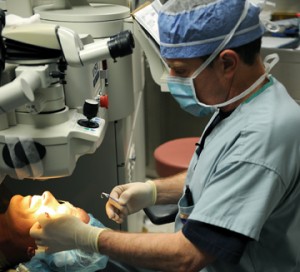Articles / News

More than 312,000 laser refractive procedures performed in the U.S. Air Force, Army and Navy have provided invaluable insight about laser refractive surgery to both military and civilian communities. Since the first military laser study began in 1993 and the U.S. Department of Defense adopted laser refractive surgery in 2000, military laser refractive cases have demonstrated safety, efficacy and excellent visual results when performed in appropriate patients. Military refractive cases have also provided accurate and large sample data that can be extrapolated to the general population. “The studies that we perform here at the Naval Medical Center San Diego are … Read more…
Visian Implantable Collamer Lens provides U.S. Bobsled Pilot with the vision to lead his Team to first Olympic Gold in 62 Years. In a historic moment for the United States bobsled team, Steven Holcomb piloted bobsled USA-1 to the Olympic gold medal in the four-man event, ending a 62-year Olympic medal drought for the American. Holcomb’s heroic mastery of the treacherous track is made even more significant by the fact that not long ago, he had 20/500 vision — “profound visual impairment” caused by keratoconus– that very nearly ended his bobsledding career. Contact lenses could no longer provide the level … Read more…
Glaucoma occurs when there is an increase of fluid production or a decrease in fluid drainage within the front part of the eye. Over time, as the pressure within the eye remains elevated or peaks at different times of the day, the optic nerve fibers are destroyed and peripheral (side) vision is lost. If not treated adequately, an elevated pressure can also cause irreversible loss of central vision. Aqueous humor flows out of the eye through the Trabecular Meshwork near the outer edge of the iris. Over time, in certain individuals with glaucoma, that trabecular meshwork becomes blocked and the … Read more…
More than 66.8 million people are visually impaired by glaucoma worldwide and the disease has blinded 6.7 million people, according to the National Glaucoma Research, a program of the American Health Assistance Foundation. The foundation is committed to funding research and getting the word out about glaucoma – January is National Glaucoma Awareness Month. People of all ages – from babies to senior citizens – are at risk for this incurable disease, which is a group of diseases that affect the optic nerve and can cause blindness without any warning or symptoms. It is not curable and any vision lost … Read more…
Laser vision correction has come full circle from its beginnings with surface phototherapeutic keratectomy and PRK. The field advanced to lamellar refractive surgery with LASIK emerging as the dominant procedure. Today, interest in advanced surface ablation has re-emerged with LASEK and other methods. Surface procedures offer several advantages compared with lamellar methods, particularly because the former avert rare but potentially devastating complications. Creating the permanent LASIK flap has been associated with the induction of higher-order aberrations and decreased corneal sensitivity as well as an increase in dry eye syndrome, striae, diffuse lamellar keratitis, infection, epithelial in-growth, and other intraoperative hurdles. … Read more…
Just 50 years ago, having cataract surgery meant general anesthesia, a five-day stay in the hospital, a high risk of infection and wearing thick corrective glasses for the rest of your life. That’s not the case today. Cataract surgery has undergone revolutionary changes since then, especially in the past decade. It’s now an outpatient procedure, taking just 20 minutes, done without stitches, usually with just a topical anesthetic. Doctors implant the corrective lens within the eye. The modern lens implant actually can improve vision by correcting a patient’s nearsightedness, farsightedness and even astigmatism – blurry vision resulting from an irregularly … Read more…
If your eyes are the windows to the soul, then Lasik eye surgery is becoming an ever-popular way of making the view less blurry. According to the Federal Trade Commission, since Lasik eye surgery was approved in 1995, laser eye centers have mushroomed from 300 in 1996 to more than 900 centers today. Five years from now, the FTC said, surgeons are expected to perform laser eye surgery on more than 3 million pairs of eyes. Dr. Dan Beers, who performs LASIK vision correction with the Peninsula Laser Vision Medical Group, located in Mountain View, said, “The key is for … Read more…